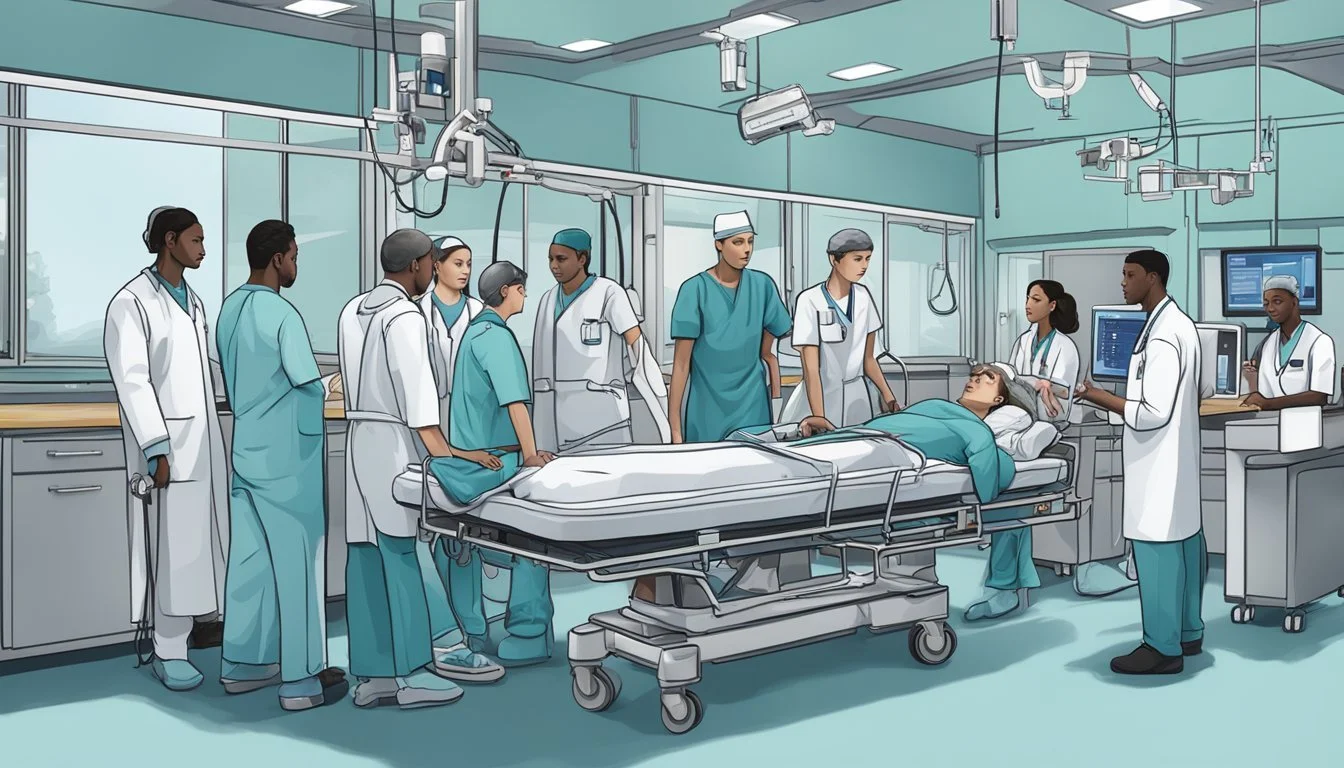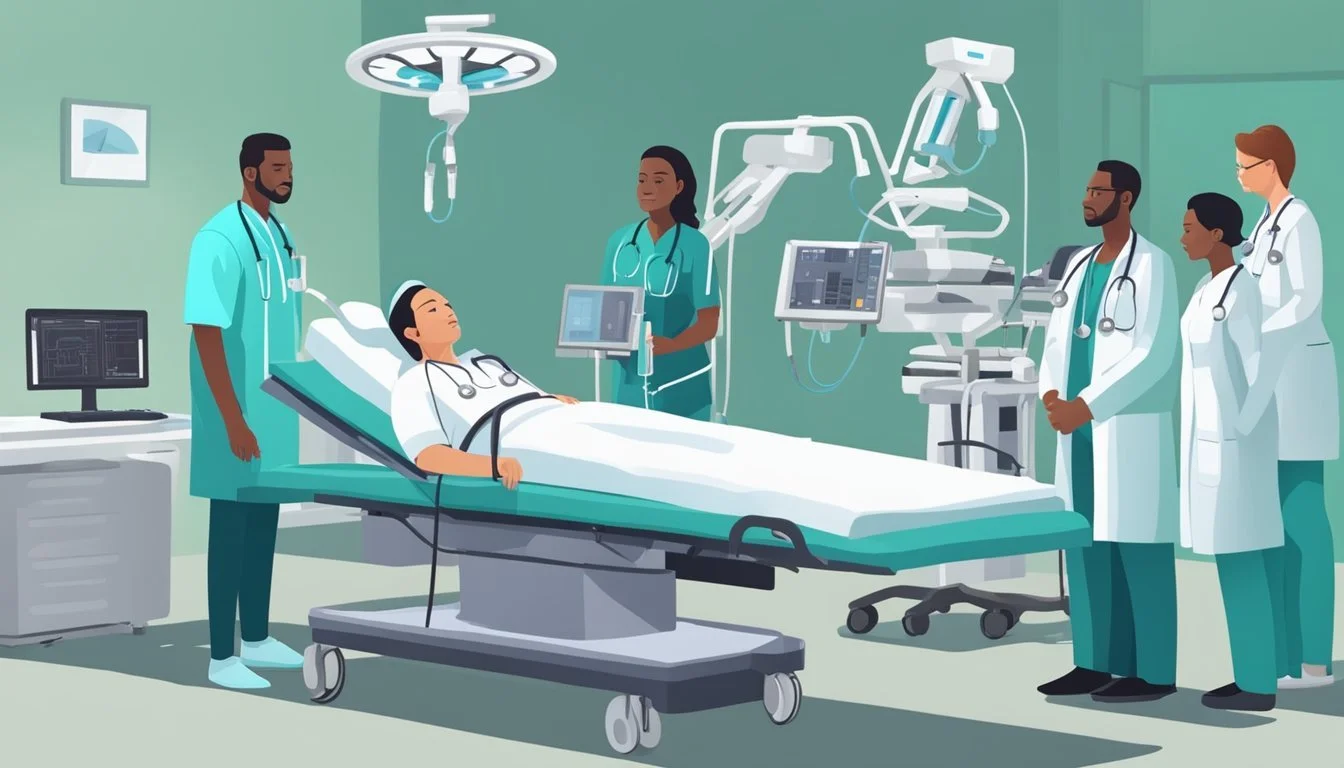Assessing Critical Priority in Trauma Patient Care
Trauma patients require rapid assessment and prioritization to ensure timely, life-saving interventions. Determining which trauma patient is most critical involves evaluating multiple factors, including mechanism of injury, vital signs, and visible injuries.
The most critical trauma patient typically exhibits signs of shock, significant blood loss, or compromised airway. Patients with unstable vital signs, especially low blood pressure, rapid heart rate, or difficulty breathing, demand immediate attention. Severe head injuries, chest trauma affecting breathing, and uncontrolled external or internal bleeding also indicate critical status.
Emergency departments use triage systems to quickly identify the most urgent cases. Trauma centers prioritize patients based on injury severity and the potential for rapid deterioration. Elderly trauma patients require special consideration, as they may have less physiological reserve to compensate for injuries. Swift, accurate assessment of trauma patients is crucial for reducing mortality and improving outcomes.
The Trauma Patient Assessment
Trauma patient assessment follows a systematic approach to rapidly identify and address life-threatening injuries. This process involves two key phases: the primary survey with resuscitation and the secondary survey for less obvious injuries.
Primary Survey and Resuscitation
The primary survey focuses on the ABCDE approach: Airway, Breathing, Circulation, Disability, and Exposure. Airway assessment ensures patency and protection. Breathing evaluation checks for adequate oxygenation and ventilation. Circulation assessment identifies and controls major hemorrhage.
Disability screening examines neurological status. Exposure involves completely undressing the patient to identify all injuries. Resuscitation efforts occur simultaneously with the primary survey.
Intravenous access is established for fluid resuscitation. Blood products may be administered for severe hemorrhage. Continuous monitoring of vital signs is crucial during this phase.
Secondary Survey: Identifying Less Obvious Injuries
The secondary survey is a head-to-toe examination to detect injuries missed during the primary survey. It includes a detailed patient history using the AMPLE mnemonic: Allergies, Medications, Past medical history, Last meal, and Events leading to injury.
Physical examination covers all body systems. Neurological assessment includes Glasgow Coma Scale scoring. Musculoskeletal evaluation checks for fractures and soft tissue injuries.
Additional diagnostic tests may be ordered based on findings. These can include X-rays, CT scans, or focused assessment with sonography in trauma (FAST) exams.
Reassessment is ongoing throughout the patient's care to detect any changes in condition or new findings.
Determinants of Criticality in Trauma Patients
Identifying the most critical trauma patients requires assessing multiple factors. These include injury severity, signs of shock, and vital organ function.
Severity of Injury
Injury severity directly impacts patient criticality. Blunt trauma from falls or motor vehicle accidents can cause widespread internal damage. Penetrating injuries from gunshots or stabbings may lead to severe bleeding.
The Injury Severity Score (ISS) helps quantify trauma severity. Higher scores indicate more critical patients. Multiple injuries to vital areas like the head, chest, or abdomen increase criticality.
Visible deformities, open fractures, or signs of internal bleeding raise concern. CT scans and focused ultrasound can reveal hidden injuries requiring urgent intervention.
Signs of Hemorrhagic Shock
Uncontrolled hemorrhage is a leading cause of preventable trauma deaths. Early recognition of shock is crucial for timely treatment.
Key signs include: • Tachycardia (rapid heart rate) • Hypotension (low blood pressure) • Cool, pale, or clammy skin • Altered mental status • Decreased urine output
Blood loss >30% of volume can trigger shock. Ongoing bleeding worsens tissue perfusion and oxygenation.
Point-of-care lactate levels help assess shock severity. Elevated lactate indicates poor tissue perfusion. Serial measurements guide resuscitation efforts.
Assessment of Vital Organ Functions
Trauma can impair critical organ systems. Careful evaluation guides treatment priorities.
Neurological: Glasgow Coma Scale assesses brain function. Scores ≤8 indicate severe injury requiring immediate airway protection.
Respiratory: Chest injuries may compromise breathing. Look for: • Respiratory distress • Decreased oxygen saturation • Abnormal breath sounds • Chest wall instability
Cardiovascular: Monitor for arrhythmias and signs of cardiac injury. Bedside echocardiography can detect pericardial effusion or wall motion abnormalities.
Renal: Urinary output reflects kidney perfusion. <0.5 mL/kg/hr suggests inadequate resuscitation or direct renal injury.
Immediate Life-Threatening Injuries
Trauma patients face critical threats from airway obstruction, severe bleeding, and brain injuries. These conditions require rapid assessment and intervention to prevent death or permanent disability.
Compromised Airway and Breathing
Airway compromise poses an immediate threat to trauma patients. Obstruction can result from facial injuries, blood, vomit, or swelling. Signs include noisy breathing, cyanosis, and altered consciousness.
Immediate interventions:
Jaw thrust or chin lift
Suction to clear secretions
Oropharyngeal or nasopharyngeal airway insertion
Endotracheal intubation for severe cases
Breathing difficulties may stem from chest injuries like pneumothorax or hemothorax. Assess respiratory rate, depth, and effort. Look for uneven chest rise, bruising, or open wounds.
Urgent actions:
Administer high-flow oxygen
Perform needle decompression for tension pneumothorax
Apply occlusive dressing for sucking chest wounds
Circulatory Collapse and Hemorrhage Control
Massive blood loss leads to shock and organ failure. External hemorrhage is visible, while internal bleeding can be occult.
Signs of shock:
Tachycardia
Hypotension
Pale, cool, clammy skin
Altered mental status
Priority actions:
Apply direct pressure to visible bleeding sites
Use tourniquets for limb hemorrhage
Apply pelvic binders for suspected pelvic fractures
Initiate large-bore IV access
Administer warmed crystalloid fluids
Identify potential sources of internal bleeding:
Chest (hemothorax)
Abdomen (solid organ injury)
Retroperitoneum (pelvic fractures)
Neurological Disability and Head Injuries
Brain injuries can rapidly deteriorate without proper management. Assess using the Glasgow Coma Scale (GCS) and pupillary response.
Key interventions:
Maintain cervical spine immobilization
Elevate head 30 degrees if no hypotension
Prevent hypoxia and hypotension
Treat increased intracranial pressure
Watch for signs of herniation:
Unilateral pupil dilation
Decerebrate or decorticate posturing
Cushing's triad (hypertension, bradycardia, irregular breathing)
Spinal cord injuries require careful handling. Maintain neutral alignment and avoid unnecessary movement. Neurogenic shock may occur with high cervical injuries, causing hypotension and bradycardia.
Trauma Resuscitation Procedures
Trauma resuscitation procedures are critical interventions aimed at stabilizing severely injured patients. These procedures focus on addressing life-threatening conditions and restoring vital functions.
Breathing Support and Chest Trauma Management
Airway management is paramount in trauma resuscitation. Endotracheal intubation may be necessary for patients with compromised airways or impaired consciousness. Oxygen therapy is administered to maintain adequate saturation levels.
For chest trauma, immediate assessment and treatment of pneumothorax and hemothorax are essential. Tension pneumothorax requires urgent needle decompression followed by chest tube placement. Chest tubes are inserted to drain blood or air from the pleural space.
Positive pressure ventilation may be required for patients with severe respiratory distress. Careful monitoring of breath sounds and chest wall movements helps identify any deterioration in respiratory status.
Blood Products and Transfusion Protocols
Massive transfusion protocols are initiated for patients with severe hemorrhage. These protocols typically involve:
Balanced ratios of packed red blood cells, fresh frozen plasma, and platelets
Early administration of tranexamic acid to reduce bleeding
Regular monitoring of coagulation parameters
Point-of-care testing guides transfusion decisions. Rapid infusion devices ensure quick delivery of blood products. Warmed fluids are used to prevent hypothermia.
Damage control resuscitation principles are applied, focusing on permissive hypotension until definitive hemorrhage control is achieved. This approach helps prevent dilutional coagulopathy and further blood loss.
Surgical and Radiological Interventions
Damage control surgery is employed for critically injured patients. This involves rapid control of hemorrhage and contamination, followed by temporary closure. Definitive repairs are performed after stabilization.
Key surgical interventions include:
Laparotomy for abdominal injuries
Thoracotomy for chest trauma
Pelvic stabilization for pelvic fractures
Interventional radiology plays a crucial role in managing certain injuries. Angioembolization can control bleeding from solid organ injuries or pelvic fractures. This minimally invasive approach can be life-saving in select cases.
Continuous reassessment and imaging guide further interventions. CT scans help identify occult injuries and guide treatment plans. Ultrasound is used for rapid assessment of free fluid in body cavities.
Trauma Systems and Prehospital Care
Trauma systems and prehospital care play crucial roles in managing critically injured patients. Effective coordination between emergency medical services, trauma centers, and specialized protocols significantly impacts patient outcomes.
Role of Emergency Medical Services
Emergency Medical Services (EMS) form the frontline of trauma care. Paramedics and EMTs provide initial assessment and treatment at the scene. They rapidly identify life-threatening conditions and initiate interventions.
Key EMS responsibilities include:
Rapid patient assessment
Airway management and breathing support
Bleeding control
Spinal immobilization
Pain management
EMS personnel make critical decisions about patient transport. They determine the most appropriate trauma center based on injury severity and proximity. Time management is crucial - minimizing on-scene time can improve patient outcomes.
Prehospital Trauma Life Support
Prehospital Trauma Life Support (PHTLS) is a standardized approach to trauma care. It provides a framework for EMS providers to assess and manage trauma patients effectively.
PHTLS principles include:
Scene safety assessment
Primary survey (ABCDE approach)
Rapid trauma assessment
Focused physical exam
This systematic approach helps identify and prioritize life-threatening injuries. It guides treatment decisions and ensures consistent, high-quality care across different EMS systems.
Communication with Trauma Centers
Effective communication between EMS and receiving trauma centers is vital. It allows hospitals to prepare for incoming patients and mobilize necessary resources.
Key elements of prehospital-hospital communication:
Patient demographics
Mechanism of injury
Vital signs and level of consciousness
Treatments provided
Estimated time of arrival
Advanced notification enables trauma teams to assemble quickly. It facilitates seamless transitions of care from prehospital to hospital settings. This coordination can significantly reduce delays in definitive treatment.
Advancements in Trauma Care
Recent years have seen significant progress in trauma care, improving patient outcomes through evidence-based practices, collaborative approaches, and innovative techniques. These advancements have transformed how medical professionals manage critical injuries and provide life-saving interventions.
Evidence-Based Protocols
Advanced Trauma Life Support (ATLS) has revolutionized trauma care by standardizing treatment protocols. This systematic approach prioritizes critical interventions, ensuring rapid assessment and management of life-threatening injuries. ATLS guidelines are regularly updated to incorporate new research findings.
Damage control strategies have gained prominence in managing severely injured patients. This approach focuses on addressing immediate threats to life before definitive repair, reducing complications and improving survival rates.
Anticoagulation management protocols have been refined for trauma patients on blood thinners. Rapid reversal agents and targeted interventions help mitigate bleeding risks in this vulnerable population.
Interprofessional Team Approach
Trauma care has evolved to embrace a collaborative model involving multiple specialties. Trauma teams now include surgeons, emergency physicians, anesthesiologists, nurses, and allied health professionals working in concert.
This interprofessional approach ensures comprehensive care from the moment a patient arrives. Each team member brings specialized expertise, contributing to faster decision-making and more efficient interventions.
Regular team training and simulations enhance coordination and communication. These exercises help identify areas for improvement and refine team dynamics, ultimately leading to better patient outcomes.
Innovative Techniques in Hemorrhage Control
Advancements in hemorrhage control have significantly improved survival rates for critically injured patients. Tourniquets have seen a resurgence in both military and civilian settings, with modern designs allowing for effective and safer application.
Novel hemostatic agents and dressings have been developed to rapidly control bleeding in challenging wound sites. These products can be particularly useful in managing injuries to areas where tourniquets are not applicable.
Interventional radiology techniques now offer minimally invasive options for controlling internal hemorrhage. These procedures can be life-saving for patients with pelvic fractures or solid organ injuries.
Chemical burns management has also seen improvements, with specialized decontamination protocols and targeted treatments to minimize tissue damage and promote healing.
Unique Considerations in Trauma Scenarios
Trauma scenarios often present complex challenges that require specialized approaches. Certain types of injuries and multiple casualty events demand tailored strategies to ensure optimal patient outcomes.
Chemical and Burn Injuries
Chemical burns require immediate decontamination to prevent further tissue damage. Remove contaminated clothing and flush the affected area with copious amounts of water. For alkali burns, prolonged irrigation is crucial.
Thermal burns necessitate rapid assessment of burn depth and percentage of body surface area affected. Use the Rule of Nines for quick estimation. Fluid resuscitation is vital for burns covering >20% of body surface area.
Inhalation injuries may not be immediately apparent. Monitor for respiratory distress and consider early intubation if airway compromise is suspected.
Maxillofacial and Extremity Trauma
Maxillofacial fractures can compromise the airway. Assess and secure the airway promptly. Perform a thorough neurological examination to rule out associated brain injuries.
Control bleeding from facial injuries. Pack open wounds and apply direct pressure. Be alert for potential cervical spine injuries.
In extremity trauma, assess neurovascular status. Check pulses, capillary refill, and sensation. Immobilize fractures to prevent further soft tissue damage.
External fixation may be necessary for open fractures or severe soft tissue injuries. This technique stabilizes bones while allowing access to wounds.
Triage and Multiple Trauma Cases
In mass casualty events, triage is essential. Use the START (Simple Triage and Rapid Treatment) method to quickly categorize patients:
Red: Immediate
Yellow: Delayed
Green: Minor
Black: Deceased
Prioritize patients with life-threatening injuries. Reassess frequently as conditions can change rapidly.
For polytrauma patients, follow the "ABCs" (Airway, Breathing, Circulation) protocol. Address the most critical injuries first. Be vigilant for occult injuries that may manifest later.
Coordinate with the trauma team to ensure efficient resource allocation. Utilize damage control strategies for severely injured patients to stabilize them before definitive treatment.
Post-Resuscitation Care and Monitoring
Effective post-resuscitation care is critical for trauma patients who have achieved return of spontaneous circulation (ROSC). It focuses on stabilizing vital functions, preventing secondary complications, and supporting organ recovery. Specialized intensive care units play a crucial role in managing these complex cases.
Roles of Intensive Care and Monitoring
Intensive care units (ICUs) provide the expertise and resources needed for post-resuscitation care. Continuous monitoring of vital signs, including heart rate, blood pressure, and oxygen saturation, is essential. Mechanical ventilation may be required to support respiratory function.
Neurological monitoring is crucial to detect and manage secondary brain injury. This includes intracranial pressure monitoring and frequent neurological assessments. Hemodynamic monitoring helps guide fluid resuscitation and vasopressor therapy to maintain adequate organ perfusion.
Patients are closely monitored for signs of multiple organ failure. Early detection and management of complications such as acute kidney injury or liver dysfunction can improve outcomes.
Surgical Aftercare and Rehabilitation
Post-resuscitation care often involves ongoing surgical management. This may include staged procedures as part of a damage control approach. Careful wound care and infection prevention are essential.
Physical therapy and early mobilization, when appropriate, help prevent complications like deep vein thrombosis and muscle wasting. Occupational therapy assists in regaining independence in daily activities.
Nutritional support is tailored to meet increased metabolic demands. Enteral feeding is preferred when feasible, but parenteral nutrition may be necessary in some cases.
Preventing Secondary Complications
Preventing secondary complications is a key focus of post-resuscitation care. Strategies include:
Stress ulcer prophylaxis
Venous thromboembolism prevention
Early removal of unnecessary catheters and lines
Targeted temperature management to prevent fever
Glucose control to avoid hyper- and hypoglycemia
Infection prevention is crucial. This includes proper hand hygiene, sterile techniques for invasive procedures, and judicious use of antibiotics.
Vigilant airway management is essential. In cases where prolonged mechanical ventilation is anticipated, a tracheostomy may be considered. Surgical cricothyroidotomy sites require special care and monitoring.
Medical Equipment and Technologies
Trauma patients require specialized medical equipment and technologies for rapid assessment and treatment. X-ray imaging plays a crucial role in identifying fractures and internal injuries quickly.
Endotracheal intubation is often necessary to secure the airway in critically injured patients. This procedure involves inserting a tube through the mouth into the trachea to maintain an open airway and assist breathing.
Mechanical ventilation supports patients who cannot breathe adequately on their own. These machines deliver precise amounts of oxygen and help remove carbon dioxide from the lungs.
Blood transfusions are vital for patients with significant blood loss. Rapid infusion devices allow for quick administration of blood products to stabilize patients in hemorrhagic shock.
Vasopressors are medications used to increase blood pressure in patients with severe shock. These drugs help maintain adequate perfusion to vital organs when standard fluid resuscitation is insufficient.
Advanced monitoring equipment tracks vital signs, including heart rate, blood pressure, and oxygen saturation. This allows medical teams to quickly identify and respond to changes in a patient's condition.
Portable ultrasound devices enable bedside assessment of internal injuries and fluid status. This technology aids in rapid diagnosis and guides treatment decisions in time-sensitive situations.




